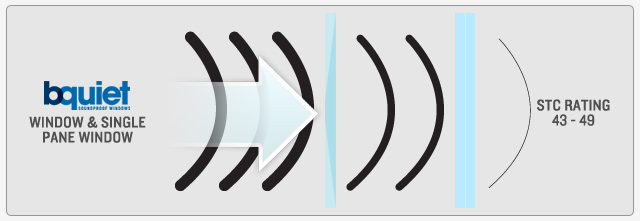Soundproofing 101…The Basics
Sound reduction is measured in STC, which stands for Sound Transmission Class. It ranges from 0-100 – 100 representing complete soundproofing and 0 representing no barrier between you and the sound. Example: If have a window open, all the sound you hear is at 0 STC. When you close the window you are now hearing the sound through a barrier (glass). The glass has an STC rating that refers to the amount of sound it has reduced. For a more scientific explanation of STC please see STC Ratings.
Sound is measured in decibels (dB). Most people can begin hearing the faintest sounds at 0 decibels. In real life these instances are rare as we are constantly exposed to some sound at any time. Even in the quietest environments, we can hear the faint sounds of appliances running, computers humming, the fan on the HVAC system and more. These sounds are in the 5-20 dB range. A whisper in a quiet library is 30dB. Generally sounds that are below 40dB are not bothersome or irritating, most of us can certainly sleep through noise levels below 40db. Now, when it comes to living close to typical softer traffic noise, with the windows closed, it usually reaches 35-45 dB, which for many people is tolerable, provided the noise remains below the 40dB range. On a main street with four lanes of traffic and all windows closed, the noise generally ranges between 40 and 50dB, which can become bothersome. This is when earplugs or pillows are typically used to block sound, or “white noise” is used (a more pleasant noise to muffle traffic noise; usually the sound of nature or something similar.)
THE HUMAN EAR
As surroundings become quieter. The human ear becomes more sensitive to noise. Therefore noise reductions by 30-40% are noticeable. However the human ear's new quiet environment allows it to pick up noises that it didn't hear before. This erases some of soundproofing provided. If outside noise is constantly above 45dB, reducing it to a level below 30dB feels like a 75-95% reduction because it will feel like the noise has virtually disappeared. This is what we achieve with our bquiet windows; levels in the 25-40dB range, which is considered a quiet environment.
Various Noise Levels
| Weakest Sound Heard | 0dB |
| Whisper Quiet Library | 30dB |
| Normal Conversations (3-5') | 60-70dB |
| Telephone Dial Tone | 80dB |
| City Traffic (from sidewalk) | 85dB |
| Train Whistle at 500', Truck Traffic | 90dB |
| Subway Train at 200' | 95dB |
| Level at which sustained exposure may result in hearing loss | 90-95dB |
| Power Mower at 3' | 107dB |
| Snowmobile, Motorcycle | 100dB |
| Power Saw at 3' | 110dB |
| Sandblasting, Loud Rock Concert | 115dB |
| Pain begins | 125dB |
| Pneumatic Riveter at 4' | 125dB |
| Even short term exposure can cause permanent damage - Loudest recommended exposure with hearing protection | 140dB |
| Jet Engine at 100', Gun Blast | 140dB |
| Death of Hearing Tissue | 180dB |
| Loudest Sound Possible | 194dB |
Back to STC ratings and how they relate to windows: Most windows are thermal and they are made up of 2 pieces of glass (usually 3mm thick) separated by a spacer. The common space between the glass is 1/2-5/8″ or 13-16mm. This configuration provides an STC rating in the 26-29 range. The chart below provides a further illustration with and without bquiet windows.
Window Glass
| Single Pane 3mm Glass | 27 |
| Thermal Glass with a 13mm Air Space | 28 |
| Triple Glazing 3x3mm Glass with 2x6mm Air Space | 31 |
| bquiet Window over a Single Glass | 43-49 |
| bquiet Window over Thermal Glass | 45-54 |
Ranges vary due to the space between the bquiet window and the primary window. The greater the distance between the two, the higher the STC rating. The optimal distance is more than 2.5″.
Triple Glazed Windows
These are great for efficiency, especially when combined with double low e coatings and 2 argon fills. When triple glazing, most manufacturers insert another piece of glass in between thermal glass therefore reducing the distance between the glass panes. This offsets the benefit of the density of another pane of glass. Sound reduction is achieved with density and space. Triple glazed windowpanes are spaced closer together than their thermal counterparts; making triple glazed windows only marginally more soundproof than thermal windows.
Exterior Walls
Walls have an STC rating ranging anywhere from 50-70. Most houses in Northern climates have more stringent building codes. Walls have to meet high R factors to provide good insulation. This also provides higher STC ratings – a well insulated home in a Northern climate has walls with STC ratings in the 60’s. This is the case in most of Canada and the Northern U.S. Therefore, if your walls have an STC of 65 and your thermal windows are 28, then all the noise you are hearing is through the windows. Increasing the STC rating of the windows so they perform similarly to the wall is the most effective strategy in reducing exterior noise.
Noise Reduction Comparisions





Want to Learn More?
Contact us today to find out more about the benefits of soundproof windows.


